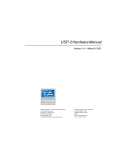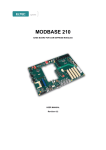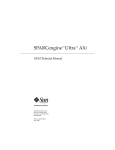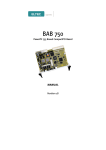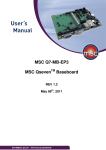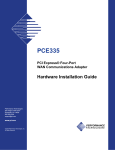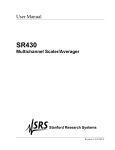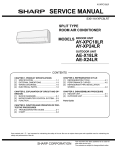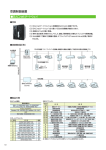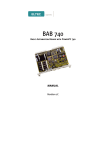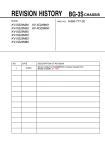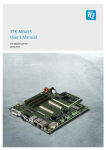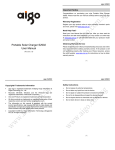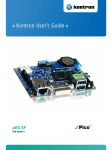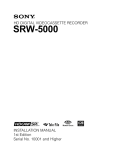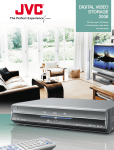Download User Manual COM Express Type 6 Carrier MSC C6-MB-EVA
Transcript
User Manual COM ExpressTM Type 6 Carrier MSC C6-MB-EVA Evaluation Board Hardware Rev. 4 Rev. 0.10 2015-02-05 MSC C6-MB-EVA - PRELIMINARY - User Manual Preface Copyright Notice Copyright © 2014 MSC Technologies GmbH. All rights reserved. Copying of this document, and giving it to others and the use or communication of the contents thereof, is forbidden without express authority. Offenders are liable to the payment of damages. All rights are reserved in the event of the grant of a patent or the registration of a utility model or design. Important Information This documentation is intended for qualified audience only. The product described herein is not an end user product. It was developed and manufactured for further processing by trained personnel. Disclaimer Although this document has been generated with the utmost care no warranty or liability for correctness or suitability for any particular purpose is implied. The information in this document is provided “as is” and is subject to change without notice. EMC Rules This unit has to be installed in a shielded housing. If not installed in a properly shielded enclosure, and used in accordance with the instruction manual, this product may cause radio interference in which case the user may be required to take adequate measures at his or her owns expense. Trademarks All used product names, logos or trademarks are property of their respective owners. Certification MSC Technologies GmbH is certified according to DIN EN ISO 9001:2000 standards. Life-Cycle-Management MSC products are developed and manufactured according to high quality standards. Our lifecycle-management assures long term availability through permanent product maintenance. Technically necessary changes and improvements are introduced if applicable. A productchange-notification and end-of-life management process assures early information of our customers. Product Support MSC engineers and technicians are committed to provide support to our customers whenever needed. Before contacting Technical Support of MSC Technologies GmbH, please consult the respective pages on our web site at www.msc-technologies.eu for the latest documentation, drivers and software downloads. If the information provided there does not solve your problem, please contact our Technical Support: Email: [email protected] Phone: +49 8165 906-200 2 / 63 MSC C6-MB-EVA - PRELIMINARY - User Manual Content 1 General Information ..................................................................................................... 6 1.1 Revision History........................................................................................................ 6 1.2 Reference Documents .............................................................................................. 6 1.3 Introduction............................................................................................................... 7 2 Technical Description................................................................................................... 7 2.1 Key Features ............................................................................................................ 7 2.2 Block diagram........................................................................................................... 9 2.3 Positioning of the Connectors, Jumpers and Switches............................................ 10 3 Mechanics ................................................................................................................. 12 3.1 Dimensions............................................................................................................. 12 3.2 Assembly notes ...................................................................................................... 12 4 Hardware ................................................................................................................... 13 4.1 Plug-in Position of the COM Express module ......................................................... 13 4.2 PCI Express Lanes ................................................................................................. 18 4.3 PCI Express x4 Slots .............................................................................................. 19 4.4 PCI Express x1 Slots .............................................................................................. 21 4.5 PCI Express Mini Card ........................................................................................... 22 4.6 PCI Express x16 Graphics Slot............................................................................... 23 4.7 ADD2 Card Slot ...................................................................................................... 26 4.8 VGA Interface ......................................................................................................... 29 4.9 DVI-D Interface ....................................................................................................... 30 4.10 High Definition Multimedia Interface (HDMI) ........................................................ 31 4.11 Display Port (DP)................................................................................................. 32 4.12 Embedded Display Port (eDP)............................................................................. 33 4.13 Alternative Embedded Display Port and HDMI Connector ................................... 35 4.14 LVDS-Interface .................................................................................................... 36 4.14.1 LVDS EEPROM Socket ................................................................................ 37 4.14.2 Backlight Inverter Interface ........................................................................... 38 4.15 Audio ................................................................................................................... 39 4.15.1 HDA Connector............................................................................................. 40 4.15.2 SPDIF ........................................................................................................... 40 4.15.3 HDA Codec Adapter (not available from Rev.4) ........................................... 40 4.16 SATA-Interface .................................................................................................... 41 4.17 mSATA Interface ................................................................................................. 42 4.18 USB Topology ..................................................................................................... 43 4.18.1 USB Power Supply ....................................................................................... 44 4.18.2 USB Connectors ........................................................................................... 44 4.18.3 USB Client Connector ................................................................................... 45 4.19 Ethernet............................................................................................................... 45 4.20 LPC Connector .................................................................................................... 45 4.21 GPIO ................................................................................................................... 47 4.21.1 GPIO Connector ........................................................................................... 48 4.21.2 SD Memory Card Connector ......................................................................... 48 4.22 COM Ports COM3 COM4 .................................................................................... 48 4.23 Super IO .............................................................................................................. 49 4.23.1 SIO Configuration ......................................................................................... 50 4.23.2 Parallel Port .................................................................................................. 50 4.23.3 COM Ports COM1 COM2 .............................................................................. 50 4.23.4 IrDA .............................................................................................................. 51 4.23.5 PS/2 Connector ............................................................................................ 51 4.23.6 Super IO Fan interface .................................................................................. 52 4.23.7 Super IO Hardware Monitor .......................................................................... 52 4.24 Fan Interface ....................................................................................................... 52 4.24.1 Intel Fan interface ......................................................................................... 52 4.25 Serial SMB EEPROM .......................................................................................... 53 3 / 63 MSC C6-MB-EVA - PRELIMINARY - User Manual 4.26 Serial I2C-Bus EEPROM ..................................................................................... 54 4.26.1 Feature I2C EEPROM................................................................................... 54 4.26.2 User I2C EEPROM ....................................................................................... 54 4.27 External SPI BIOS-Flash ..................................................................................... 54 4.28 POST-Code Display ............................................................................................ 54 4.28.1 Lattice Programming Interface ...................................................................... 54 4.29 Feature Connector .............................................................................................. 56 4.30 Power Supply ATX Connector ............................................................................. 56 4.31 Power Supply Labor Connector ........................................................................... 57 4.32 Battery................................................................................................................. 58 4.33 Beeper ................................................................................................................ 58 4.34 Power Button ....................................................................................................... 58 4.35 Reset Button ....................................................................................................... 58 4.36 Sleep Button ........................................................................................................ 58 4.37 Clear Event Button .............................................................................................. 58 4.38 LEDs ................................................................................................................... 59 4.39 WLAN LEDs ........................................................................................................ 59 4.40 DIP Switches ....................................................................................................... 60 4.41 Miscellaneous...................................................................................................... 60 4.41.1 Resistors for current measuring .................................................................... 60 4.41.2 Ground Pins .................................................................................................. 60 4.41.3 Power supply current measuring ................................................................... 61 4.42 Graphic Port Selection......................................................................................... 62 4.42.1 JILI30 / eDP Selection................................................................................... 63 4.42.2 DDI Port Selection ........................................................................................ 63 Illustrations Illustration 1 Block Diagram ................................................................................................... 9 Illustration 2 Connectors overview ....................................................................................... 10 Illustration 3 Picture ............................................................................................................. 11 Illustration 4 Miscellaneous Parts ........................................................................................ 57 Illustration 5 Current Measurement...................................................................................... 61 Illustration 6 Block Diagram Graphics Ports ......................................................................... 62 Tables Table 1 COMExpress Connector Rows A and B ................................................................ 15 Table 2 COMExpress Connector Rows C and D ............................................................... 17 Table 3 Assignment PCIe Lane to connector reference ..................................................... 18 Table 4 PCIe Lane configuration ....................................................................................... 18 Table 5 Pin out PCI Express.............................................................................................. 20 Table 6 Pin out PCI Express.............................................................................................. 22 Table 7 Pin out PCI Express x16 Graphics Slot ................................................................. 25 Table 8 Pin out ADD2 Card Slot ........................................................................................ 28 Table 8 Pin-out VGA Interface ........................................................................................... 30 Table 9 Pin-out DVI-D Interface ......................................................................................... 30 Table 11 Pin-out HDMI ...................................................................................................... 32 Table 12 Pin-out Display Port ............................................................................................ 32 Table 13 Pin-out embedded Display Port .......................................................................... 34 Table 14 Pin-out eDP Backlight Power Supply Connector ................................................. 34 Table 15 Pin-out JILI30 LVDS-Interface ............................................................................ 37 Table 16 Pin-out LVDS EEPROM Socket .......................................................................... 38 Table 17 EEPROM Address JP1601 ................................................................................. 38 Table 18 Pin-out Backlight ................................................................................................. 38 Table 19 Pin-out LineOut ................................................................................................... 40 4 / 63 MSC C6-MB-EVA Table 20 Table 21 Table 22 Table 23 Table 24 Table 25 Table 26 Table 27 Table 28 Table 29 Table 30 Table 31 Table 32 Table 33 Table 34 Table 35 Table 36 Table 37 Table 38 Table 39 Table 40 Table 41 Table 42 Table 43 Table 44 Table 45 Table 46 Table 47 Table 48 Table 49 - PRELIMINARY - User Manual Pin-out SPDIF..................................................................................................... 40 Pin-out HAD Codec Adapter ............................................................................... 40 Assignment SATA Channel to Connector Reference .......................................... 41 Pin-out mSATA socket ........................................................................................ 42 Assignment USB Ports ....................................................................................... 43 Pin-out USB 2.0 pin header ................................................................................ 44 Pin-out USB 2.0 pin header ................................................................................ 44 USB Client Connector ......................................................................................... 45 Pin-out LPC-Slot ................................................................................................. 46 Pin-out GPIO connector ...................................................................................... 48 Pin-out COM Ports.............................................................................................. 48 SIO Configuration ............................................................................................... 50 Pin-out LPT Port ................................................................................................. 50 Pin-out COM Ports.............................................................................................. 51 Pin-out IrDA ........................................................................................................ 51 Pin-out PS/2 Connector ...................................................................................... 51 Pin-out SIO Fan Interface ................................................................................... 52 Pin-out Fan Interface .......................................................................................... 52 Jumper SMB EEPROM Address......................................................................... 53 Jumper Feature I2C EEPROM Address .............................................................. 54 Jumper User I2C EEPROM Address .................................................................. 54 Jumper BIOS selection ....................................................................................... 54 POST-Code Selection......................................................................................... 54 Pin-out Lattice Programming Interface ................................................................ 55 Pin-out Feature connector .................................................................................. 56 Pin-out Power IN3 connector .............................................................................. 57 LEDs Overview ................................................................................................... 59 DIP Switch Overview .......................................................................................... 60 JILI30 / eDP Selection ........................................................................................ 63 DDI Port Selection .............................................................................................. 63 5 / 63 MSC C6-MB-EVA - PRELIMINARY - User Manual 1 General Information 1.1 Revision History Rev. Date 0.1 0.2 26.07.2012 10.8.2012 0.3 19.09.2012 0.4 0.5 0.6 0.7 0.8 0.9 0.10 2012-11-08 2013-04-15 2013-07-22 2013-11-15 2014-03-19 2014-09-05 2015-02-05 Description Initial Revision Minor changes Due to new board revision: The eDP connector X1501 changed from 40 to 30 pin and the pin assignment at COM ports has changed. Minor changes Adaption to new board revision (LY30E801) SD memory card slot, DIP-switch setting for LY30E801 Remarks concerning to LY30E801 added Adaption to new board revision (LY40E801) New covering page Table44 Pin21 corrected 1.2 Reference Documents [1] COM Express Module Base Specification COM Express Revision 2.1 Last update: Apr10th, 2012 [2] PCI Local Bus Specification Rev. 2.1 PCI21.PDF Last update: June 1st, 1995 http://www.pcisig.com [3] JILI Specification Jilim120.pdf Last update: April 7th, 2003 http://www.jumptec.de/product/data/jili/index.html [4] Serial ATA Specification Serial ATA 1.0 gold.pdf Last update: August 29th, 2002 Rev.1.0 http://www.sata-io.org/ [5] IEEE Std. 802.3-2002 802.3-2002.pdf http://www.ieee.org [6] Universal Bus Specification usb_20.pdf Last update: April 27th, 2000 http://www.usb.org [7] Digital Video Interface DVI dvi_10.pdf Rev. 1.0 April 2nd, 1999 http://www.ddwg.org/ 6 / 63 MSC C6-MB-EVA - PRELIMINARY - User Manual 1.3 Introduction COM Express™, is an open specification from the PICMG (PCI Industrial Computer Manufacturer Group). It is a module concept to bring PCI Express and other new technologies like SATA, USB 3.0 and different display interfaces onto a COM (Computer On Module). A COM Express™ module is plugged onto an application-specific base board which provides the necessary I/O connectors and may also contain application-specific additional logic circuitry. Typically a COM Express module consists of CPU, chipset, memory, video controller, Ethernet controller, BIOS Flash, SATA- and USB controller. More I/O controllers and all I/O connectors are implemented on the base board on to which the COM Express module can be plugged via one or two 220-pin SMD-connectors. Beside the power supply also signals for PCIe bus, displays, SATA, USB, LPC etc. are present on these connectors. The type of interfaces that is led from the COM Express module to the base board depends on the type of module that is used. The COM Express specification defines seven different types which differ in number and pin assignment of the module connectors. Thanks to the standardized mechanics and interfaces the system can be scaled arbitrarily. In spite of the modular concept the systems design is very flat and compact. COM Express modules require a base-board for successful operation. The base board described below acts as an evaluation board for COM Express modules with pin-out Type 6. 2 Technical Description 2.1 Key Features The MSC C6-MB-EVA COM Express base board is designed as a type 6 carrier board. Key features include: Interface for COM Express module type 6 up to basic form factor Dual 220 pin connector (440 pins) 1 PCIe x4 slot 4 PCIe x1 slots shared with 1 PCIe x4 slot and / or PCIe mini card PCIe x16 graphics slot (PEG) VGA interface LVDS interface (JILI30) 3 Digital Display Interfaces /shared with card slot 1 DVI connector 2 HDMI connectors / 2 DP connectors 1 eDP connector (40pin) 4 USB3.0 root hub interfaces 4 USB2.0 root hub interfaces 4 SATA channels up to 300MB/s mSATA shared with one standard SATA channel High definition digital audio codec ALC888 or pin header 6 audio jacks SPDIF on pin header GBit Ethernet interface Feature connector 7 / 63 MSC C6-MB-EVA - PRELIMINARY - User Manual LPC header Pin header for GPIOs SuperIO W83627HG PS/2, 2x COM (SIO), LPT, IRDA, fan interfaces Power supply via ATX connector or +12V only POST display on LPC Serial EEPROM on I²C-Bus Serial EEPROM on SMBus On-board SPI Flash socket Beeper 2x COM (module) 3V battery Note: Support for all above features will also depend on the COM Express module being used. Not all modules support the maximum number of interfaces. 8 / 63 MSC C6-MB-EVA - PRELIMINARY - User Manual 2.2 Block diagram Illustration 1 Block Diagram 9 / 63 MSC C6-MB-EVA - PRELIMINARY - 2.3 Positioning of the Connectors, Jumpers and Switches Illustration 2 Connectors overview 10 / 63 User Manual MSC C6-MB-EVA - PRELIMINARY - Illustration 3 Picture 11 / 63 User Manual MSC C6-MB-EVA - PRELIMINARY - 3 Mechanics 3.1 Dimensions Dimension: 243.8 mm x 304.8 mm Width: 1.6 mm + /-10% Tolerances of the drill holes: +/- 0.1mm in X and Y Tolerances of the diameter: + 0.1 mm 3.2 Assembly notes Use these bolts for mounting different form factors: COM Express Mini: 4x M2.5 x 5mm bolt COM Express Compact: 4x M2.5 x 5mm bolt COM Express Basic: 5x M2.5 x 5mm bolt 12 / 63 User Manual MSC C6-MB-EVA - PRELIMINARY - 4 Hardware 4.1 Plug-in Position of the COM Express module Socket for a COM Express type 6 module is available on the base board. Following form factors are supported: Mini Module Compact Module Basic Module Specification: Reference: Connector:AMP / Tyco 3-1827233-6 0.5 mm pitch free height 440 pin 5H plug (combination of two 220pin plugs) Pin-out: [1] X301 Refer to COM Express specification for type 6 module 13 / 63 User Manual MSC C6-MB-EVA Row A A1 A2 A3 A4 A5 A6 A7 A8 A9 A10 A11 A12 A13 A14 A15 A16 A17 A18 A19 A20 A21 A22 A23 A24 A25 A26 A27 A28 A29 A30 A31 A32 A33 A34 A35 A36 A37 A38 A39 A40 A41 A42 A43 A44 A45 A46 A47 A48 A49 A50 A51 A52 A53 A54 A55 - PRELIMINARY - Row B B1 B2 B3 B4 B5 B6 B7 B8 B9 B10 B11 B12 B13 B14 B15 B16 B17 B18 B19 B20 B21 B22 B23 B24 B25 B26 B27 B28 B29 B30 B31 B32 B33 B34 B35 B36 B37 B38 B39 B40 B41 B42 B43 B44 B45 B46 B47 B48 B49 B50 B51 B52 B53 B54 B55 GND GBE0_MDI3GBE0_MDI3+ GBE0_LINK100# GBE0_LINK1000# GBE0_MDI2GBE0_MDI2+ GBE0_LINK# GBE0_MDI1GBE0_MDI1+ GND GBE0_MDI0GBE0_MDI0+ GBE0_CTREF SUS_S3# SATA0_TX+ SATA0_TXSUS_S4# SATA0_RX+ SATA0_RXGND SATA2_TX+ SATA2_TXSUS_S5# SATA2_RX+ SATA2_RXBATLOW# ATA_ACT# AC/HDA_SYNC AC/HDA_RST# GND AC/HDA_BITCLK AC/HDA_SDOUT BIOS_DIS0# THRMTRIP# USB6USB6+ USB_6_7_OC# USB4USB4+ GND USB2USB2+ USB_2_3_OC# USB0USB0+ VCC_RTC EXCD0_PERST# EXCD0_CPPE# LPC_SERIRQ GND PCIE_TX5+ PCIE_TX5GPI0 PCIE_TX4+ 14 / 63 User Manual GND GBE0_ACT# LPC_FRAME# LPC_AD0 LPC_AD1 LPC_AD2 LPC_AD3 LPC_DRQ0# LPC_DRQ1# LPC_CLK GND PWRBTN# SMB_CK SMB_DAT SMB_ALERT# SATA1_TX+ SATA1_TXSUS_STAT# SATA1_RX+ SATA1_RXGND SATA3_TX+ SATA3_TXPWR_OK SATA3_RX+ SATA3_RXWDT AC/HDA_SDIN2 AC/HDA_SDIN1 AC/HDA_SDIN0 GND SPKR I2C_CK I2C_DAT THRM# USB7USB7+ USB_4_5_OC# USB5USB5+ GND USB3USB3+ USB_0_1_OC# USB1USB1+ EXCD1_PERST# EXCD1_CPPE# SYS_RESET# CB_RESET# GND PCIE_RX5+ PCIE_RX5GPO1 PCIE_RX4+ MSC C6-MB-EVA - PRELIMINARY - A56 PCIE_TX4B56 A57 GND B57 A58 PCIE_TX3+ B58 A59 PCIE_TX3B59 A60 GND B60 A61 PCIE_TX2+ B61 A62 PCIE_TX2B62 A63 GPI1 B63 A64 PCIE_TX1+ B64 A65 PCIE_TX1B65 A66 GND B66 A67 GPI2 B67 A68 PCIE_TX0+ B68 A69 PCIE_TX0B69 A70 GND B70 A71 LVDS_A0+ B71 A72 LVDS_A0B72 A73 LVDS_A1+ B73 A74 LVDS_A1B74 A75 LVDS_A2+ B75 A76 LVDS_A2B76 A77 LVDS_VDD_EN B77 A78 LVDS_A3+ B78 A79 LVDS_A3B79 A80 GND B80 A81 LVDS_A_CK+ B81 A82 LVDS_A_CKB82 A83 LVDS_I2C_CK B83 A84 LVDS_I2C_DAT B84 A85 GPI3 B85 A86 RSVD B86 A87 eDP_HPD B87 A88 PCIE0_CK_REF+ B88 A89 PCIE0_CK_REFB89 A90 GND B90 A91 SPI_POWER B91 A92 SPI_MISO B92 A93 GPO0 B93 A94 SPI_CLK B94 A95 SPI_MOSI B95 A96 TPM_PP B96 A97 TYPE10# B97 A98 SER0_TX B98 A99 SER0_RX B99 A100 GND B100 A101 SER1_TX B101 A102 SER1_RX B102 A103 LID# B103 A104 VCC_12V B104 A105 VCC_12V B105 A106 VCC_12V B106 A107 VCC_12V B107 A108 VCC_12V B108 A109 VCC_12V B109 A110 GND B110 Table 1 COMExpress Connector Rows A and B 15 / 63 User Manual PCIE_RX4GPO2 PCIE_RX3+ PCIE_RX3GND PCIE_RX2+ PCIE_RX2GPO3 PCIE_RX1+ PCIE_RX1WAKE0# WAKE1# PCIE_RX0+ PCIE_RX0GND LVDS_B0+ LVDS_B0LVDS_B1+ LVDS_B1LVDS_B2+ LVDS_B2LVDS_B3+ LVDS_B3LVDS_BKLT_EN GND LVDS_B_CK+ LVDS_B_CKLVDS_BKLT_CTRL VCC_5V_SBY VCC_5V_SBY VCC_5V_SBY VCC_5V_SBY BIOS_DIS1# VGA_RED GND VGA_GRN VGA_BLU VGA_HSYNC VGA_VSYNC VGA_I2C_CK VGA_I2C_DAT SPI_CS# RSVD RSVD GND FAN_PWNOUT FAN_TACHIN SLEEP# VCC_12V VCC_12V VCC_12V VCC_12V VCC_12V VCC_12V GND MSC C6-MB-EVA Row C C1 C2 C3 C4 C5 C6 C7 C8 C9 C10 C11 C12 C13 C14 C15 C16 C17 C18 C19 C20 C21 C22 C23 C24 C25 C26 C27 C28 C29 C30 C31 C32 C33 C34 C35 C36 C37 C38 C39 C40 C41 C42 C43 C44 C45 C46 C47 C48 C49 C50 C51 C52 C53 C54 C55 - PRELIMINARY - Row D D1 D2 D3 D4 D5 D6 D7 D8 D9 D10 D11 D12 D13 D14 D15 D16 D17 D18 D19 D20 D21 D22 D23 D24 D25 D26 D27 D28 D29 D30 D31 D32 D33 D34 D35 D36 D37 D38 D39 D40 D41 D42 D43 D44 D45 D46 D47 D48 D49 D50 D51 D52 D53 D54 D55 GND GND USB_SSRX0USB_SSRX0+ GND USB_SSRX1USB_SSRX1+ GND USB_SSRX2USB_SSRX2+ GND USB_SSRX3USB_SSRX3+ GND DDI1_PAIR6+ DDI1_PAIR6RSVD RSVD PCIE_RX6+ PCIE_RX6GND PCIE_RX7+ PCIE_RX7DDI1_HPD DDI1_PAIR4+ DDI1_PAIR4RSVD RSVD DDI1_PAIR5+ DDI1_PAIR5GND DDI2_CTRLCLK_AUX+ DDI2_CTRLDATA_AUXDDI2_DDC_AUX_SEL RSVD DDI3_CTRLCLK_AUX+ DDI3_CTRLDATA_AUXDDI3_DDC_AUX_SEL DDI3_PAIR0+ DDI3_PAIR0GND DDI3_PAIR1+ DDI3_PAIR1DDI3_HPD RSVD DDI3_PAIR2+ DDI3_PAIR2RSVD DDI3_PAIR3+ DDI3_PAIR3GND PEG_RX0+ PEG_RX0TYPE0# PEG_RX1+ 16 / 63 User Manual GND GND USB_SSTX0USB_SSTX0+ GND USB_SSTX1USB_SSTX1+ GND USB_SSTX2USB_SSTX2+ GND USB_SSTX3USB_SSTX3+ GND DDI1_CTRLCLK_AUX+ DDI1_CTRLDATA_AUXRSVD RSVD PCIE_TX6+ PCIE_TX6GND PCIE_TX7+ PCIE_TX7RSVD RSVD DDI1_PAIR0+ DDI1_PAIR0RSVD DDI1_PAIR1+ DDI1_PAIR1GND DDI1_PAIR2+ DDI1_PAIR2DDI1_DDC_AUX_SEL RSVD DDI1_PAIR3+ DDI1_PAIR3RSVD DDI2_PAIR0+ DDI2_PAIR0GND DDI3_PAIR1+ DDI3_PAIR1DDI2_HPD RSVD DDI3_PAIR2+ DDI3_PAIR2RSVD DDI3_PAIR3+ DDI3_PAIR3GND PEG_TX0+ PEG_TX0PEG_LANE_RV# PEG_TX1+ MSC C6-MB-EVA - PRELIMINARY - C56 PEG_RX1D56 C57 TYPE1# D57 C58 PEG_RX2+ D58 C59 PEG_RX2D59 C60 GND D60 C61 PEG_RX3+ D61 C62 PEG_RX3D62 C63 RSVD D63 C64 RSVD D64 C65 PEG_RX4+ D65 C66 PEG_RX4D66 C67 RSVD D67 C68 PEG_RX5+ D68 C69 PEG_RX5D69 C70 GND D70 C71 PEG_RX6+ D71 C72 PEG_RX6D72 C73 GND D73 C74 PEG_RX7+ D74 C75 PEG_RX7D75 C76 GND D76 C77 RSVD D77 C78 PEG_RX8+ D78 C79 PEG_RX8D79 C80 GND D80 C81 PEG_RX9+ D81 C82 PEG_RX9D82 C83 RSVD D83 C84 GND D84 C85 PEG_RX10+ D85 C86 PEG_RX10D86 C87 GND D87 C88 PEG_RX11+ D88 C89 PEG_RX11D89 C90 GND D90 C91 PEG_RX12+ D91 C92 PEG_RX12D92 C93 GND D93 C94 PEG_RX13+ D94 C95 PEG_RX13D95 C96 GND D96 C97 RSVD D97 C98 PEG_RX14+ D98 C99 PEG_RX14D99 C100 GND D100 C101 PEG_RX15+ D101 C102 PEG_RX15D102 C103 GND D103 C104 VCC_12V D104 C105 VCC_12V D105 C106 VCC_12V D106 C107 VCC_12V D107 C108 VCC_12V D108 C109 VCC_12V D109 C110 GND D110 Table 2 COMExpress Connector Rows C and D 17 / 63 User Manual PEG_TX1TYPE2# PEG_TX2+ PEG_TX2GND PEG_TX3+ PEG_TX3RSVD RSVD PEG_TX4+ PEG_TX4GND PEG_TX5+ PEG_TX5GND PEG_TX6+ PEG_TX6GND PEG_TX7+ PEG_TX7GND RSVD PEG_TX8+ PEG_TX8GND PEG_TX9+ PEG_TX9RSVD GND PEG_TX10+ PEG_TX10GND PEG_TX11+ PEG_TX11GND PEG_TX12+ PEG_TX12GND PEG_TX13+ PEG_TX13GND PEG_ENABLE# PEG_TX14+ PEG_TX14GND PEG_TX15+ PEG_TX15GND VCC_12V VCC_12V VCC_12V VCC_12V VCC_12V VCC_12V GND MSC C6-MB-EVA - PRELIMINARY - User Manual 4.2 PCI Express Lanes 8 PCIe lanes are defined at the COM Express module. Some lanes can be routed to various connectors. Note: The number of PCIe lanes available will depend on the COM Express module used – not all modules can support 8 PCIe lanes. References References default Change via resistors PCIe Lane 0 X701 Slot 0 PCIe Lane 1 X701 Slot 0 PCIe Lane 2 X701 Slot 0 PCIe Lane 3 X701 Slot 0 PCIe Lane 4 X702 Slot 1 X702 Slot 1 PCIe Lane 5 X801 Slot 2 X702 Slot 1 PCIe Lane 6 X802 Slot 3 X702 Slot 1 PCIe Lane 7 X803 Slot 4 Table 3 Assignment PCIe Lane to connector reference PCIe Lane References Change via switch X901 Mini PCIe To change PCIe lanes from Slot 1 to Slots 2/3/4 remove resistors and replace them at: PCIe Lane PCIe Lane 5 PCIe Lane 6 Remove (red) RJ713, RJ714, RJ715, RJ716 RJ717, RJ718, RJ719, RJ720 RJ721, RJ722, RJ723, RJ724 Table 4 PCIe Lane configuration PCIe Lane 7 place at (green) Mini PCIe RJ701, RJ702, RJ707, RJ708 Don’t move resistors. When RJ703, RJ704, plugging the device, lane 6 RJ709, RJ710 switches automatic. RJ705, RJ706, RJ711, RJ712 18 / 63 MSC C6-MB-EVA - PRELIMINARY - User Manual 4.3 PCI Express x4 Slots Specification: References: Connector:FCI 10018784 Pin-out: PCIe slots are not hot-plug capable Pin A1 A2 A3 A4 A5 A6 A7 X701, X702 Refer to PCI express specification Signal PRSNT1# 12V 12V GND JTAG_TCK JTAG_TDI JTAG_TDO Pin B1 B2 B3 B4 B5 B6 B7 19 / 63 Signal 12V 12V 12V GND SMB_CLK SMB_DAT GND MSC C6-MB-EVA - PRELIMINARY - A8 JTAG_TMS A9 3V3 A10 3V3 A11 PE_RST# KEY A12 GND A13 REFCLK+ A14 REFCLKA15 GND A16 PER_p0 A17 PER_n0 A18 GND A19 RSVD A20 GND A21 PER_p1 A22 PER_n1 A23 GND A24 GND A25 PER_p2 A26 PER_n2 A27 GND A28 GND A29 PER_p3 A30 PER_n3 A31 GND A32 RSVD Table 5 Pin out PCI Express 20 / 63 User Manual B8 B9 B10 B11 3V3 JTAG_RST# 3V3_AUX WAKE# B12 B13 B14 B15 B16 B17 B18 B19 B20 B21 B22 B23 B24 B25 B26 B27 B28 B29 B30 B31 B32 RSVD GND PET_p0 PET_n0 GND PRSNT2# GND PET_p1 PET_n1 GND PRSNT2# PET_p2 PET_n2 GND GND PET_p3 PET_n3 GND RSVD PRSNT2# GND MSC C6-MB-EVA - PRELIMINARY - User Manual 4.4 PCI Express x1 Slots Specification: X801 – X803 References: Connector:AMP / Tyco 4-1612163-1 Pin-out: PCIe slots are not hot-plug capable Pin A1 A2 A3 A4 A5 A6 A7 A8 A9 A10 Refer to PCI express specification Signal PRSNT1# 12V 12V GND JTAG_TCK JTAG_TDI JTAG_TDO JTAG_TMS 3V3 3V3 Pin B1 B2 B3 B4 B5 B6 B7 B8 B9 B10 21 / 63 Signal 12V 12V 12V GND SMB_CLK SMB_DAT GND 3V3 JTAG_RST# 3V3_AUX MSC C6-MB-EVA - PRELIMINARY - A11 PE_RST# KEY A12 GND A13 REFCLK+ A14 REFCLKA15 GND A16 PER_p0 A17 PER_n0 A18 GND Table 6 Pin out PCI Express User Manual B11 WAKE# B12 B13 B14 B15 B16 B17 B18 RSVD GND PET_p0 PET_n0 GND PRSNT2# GND 4.5 PCI Express Mini Card PCIe Lane 6 and the signals from USB port 6 switch automatic to this slot if a card is plugged. It can be selected with DIP switch 2 at S2901. If the Mini Card slot is selected, PCIe-Slot 3 and USB port 6 at X2002 are no longer useable. With the W_DISABLE# jumper J901 the card slot can be set write protected. If the assembled Mini Card do not support CLKREQ# signal, the jumper J902 enables the PCIe-clock signal at the Mini Card slot. Note: At rev. 3 carrier (LY30E801) the USB port 6 signals are not routed to X901. They are still useable at X2002. Specification: References: Connector: Molex 67910-9000 Pin-out: X901 Refer to PCIe Mini Card Specification 22 / 63 MSC C6-MB-EVA - PRELIMINARY - User Manual 4.6 PCI Express x16 Graphics Slot A PCIe x16 graphics slot is provided for insertion of PEG graphics cards. Specification: References: Connector:AMP / Tyco 4-1612163-4 Pin-out: X501 Refer to PCI express specification Pin D54 can be set to ground with PEG_LANE_RV# jumper J504. Pin A1 A2 A3 A4 A5 A6 A7 Signal PRSNT1# 12V 12V GND JTAG_TCK JTAG_TDI JTAG_TDO Pin B1 B2 B3 B4 B5 B6 B7 23 / 63 Signal 12V 12V 12V GND SMB_CLK SMB_DAT GND MSC C6-MB-EVA A8 A9 A10 A11 KEY A12 A13 A14 A15 A16 A17 A18 A19 A20 A21 A22 A23 A24 A25 A26 A27 A28 A29 A30 A31 A32 A33 A34 A35 A36 A37 A38 A39 A40 A41 A42 A43 A44 A45 A46 A47 A48 A49 A50 A51 A52 A53 A54 A55 A56 A57 A58 A59 A60 A61 A62 - PRELIMINARY - User Manual JTAG_TMS 3V3 3V3 PE_RST# B8 B9 B10 B11 3V3 JTAG_RST# 3V3_AUX WAKE# GND REFCLK+ REFCLKGND PER_p0 PER_n0 GND RSVD GND PER_p1 PER_n1 GND GND PER_p2 PER_n2 GND GND PER_p3 PER_n3 GND RSVD RSVD GND PER_p4 PER_n4 GND GND PER_p5 PER_n5 GND GND PER_p6 PER_n6 GND GND PER_p7 PER_n7 GND RSVD GND PER_p8 PER_n8 GND GND PER_p9 PER_n9 GND GND PER_p10 PER_n10 GND B12 B13 B14 B15 B16 B17 B18 B19 B20 B21 B22 B23 B24 B25 B26 B27 B28 B29 B30 B31 B32 B33 B34 B35 B36 B37 B38 B39 B40 B41 B42 B43 B44 B45 B46 B47 B48 B49 B50 B51 B52 B53 B54 B55 B56 B57 B58 B59 B60 B61 B62 RSVD GND PET_p0 PET_n0 GND PRSNT2# GND PET_p1 PET_n1 GND GND PET_p2 PET_n2 GND GND PET_p3 PET_n3 GND RSVD PRSNT2# GND PET_p4 PET_n4 GND GND PET_p5 PET_n5 GND GND PET_p6 PET_n6 GND GND PET_p7 PET_n7 GND PRSNT2# GND PET_p8 PET_n8 GND GND PET_p9 PET_n9 GND GND PET_p10 PET_n10 GND GND PET_p11 24 / 63 MSC C6-MB-EVA A63 A64 A65 A66 A67 A68 A69 A70 A71 A72 A73 A74 A75 A76 A77 A78 A79 A80 A81 - PRELIMINARY - GND PER_p11 PER_n11 GND GND PER_p12 PER_n12 GND GND PER_p13 PER_n13 GND GND PER_p14 PER_n14 GND GND PER_p15 PER_n15 B63 B64 B65 B66 B67 B68 B69 B70 B71 B72 B73 B74 B75 B76 B77 B78 B79 B80 B81 A82 GND B82 Table 7 Pin out PCI Express x16 Graphics Slot 25 / 63 User Manual PET_n11 GND GND PET_p12 PET_n12 GND GND PET_p13 PET_n13 GND GND PET_p14 PET_n14 GND GND PET_p15 PET_n15 GND PRSNT2# (PEG_ENABLE#, D97 at X301) RSVD MSC C6-MB-EVA - PRELIMINARY - User Manual 4.7 ADD2 Card Slot The digital display interfaces can be switched to the ADD2-N (Advanced Digital Display - Normal) card slot. Refer to chapter 4.42. Specification: References: Connector:AMP / Tyco 4-1612163-4 Pin-out: Pin A1 A2 A3 A4 X601 Refer to PCI express specification Signal PRSNT1# 12V 12V GND Pin B1 B2 B3 B4 26 / 63 Signal 12V 12V 12V GND MSC C6-MB-EVA A5 A6 A7 A8 A9 A10 A11 KEY A12 A13 A14 A15 A16 A17 A18 A19 A20 A21 A22 A23 A24 A25 A26 A27 A28 A29 A30 A31 A32 A33 A34 A35 A36 A37 A38 A39 A40 A41 A42 A43 A44 A45 A46 A47 A48 A49 A50 A51 A52 A53 A54 A55 A56 A57 A58 A59 - PRELIMINARY - User Manual JTAG_TCK JTAG_TDI JTAG_TDO JTAG_TMS 3V3 3V3 PE_RST# B5 B6 B7 B8 B9 B10 B11 SMB_CLK SMB_DAT GND 3V3 JTAG_RST# 3V3_AUX WAKE# GND REFCLK+ / n.c. REFCLK- / n.c. GND PER_p0 / DDI1 LANE 5+ PER_n0 / DDI1 LANE 5GND RSVD GND PER_p1 / DDI1 LANE4+ PER_n1 / DDI1 LANE 4GND GND PER_p2 / DDI1 AUX+ PER_n2 / DDI1 AUXGND GND PER_p3 / DDI1 HPD PER_n3 / DDI1 AUX SEL GND RSVD RSVD GND PER_p4 / n.c. PER_n4 / n.c. GND GND PER_p5 / n.c. PER_n5 / n.c. GND GND PER_p6 / DDI2 AUX+ PER_n6 / DDI2 AUXGND GND PER_p7 / DDI2 HPD PER_n7 / DDI2 AUX SEL GND RSVD GND PER_p8 / n.c. PER_n8 / n.c. GND GND PER_p9 / n.c. PER_n9 / n.c. GND GND B12 B13 B14 B15 B16 B17 B18 B19 B20 B21 B22 B23 B24 B25 B26 B27 B28 B29 B30 B31 B32 B33 B34 B35 B36 B37 B38 B39 B40 B41 B42 B43 B44 B45 B46 B47 B48 B49 B50 B51 B52 B53 B54 B55 B56 B57 B58 B59 RSVD GND PET_p0 / DDI1 LANE0+ PET_n0 / DDI1 LANE0GND PRSNT2# / DDI1 AUX SW+ GND PET_p1 / DDI1 LANE1+ PET_n1 / DDI1 LANE1GND GND PET_p2 / DDI1 LANE2+ PET_n2 / DDI1 LANE2GND GND PET_p3 / DDI1 LANE3+ PET_n3 / DDI1 LANE3GND RSVD PRSNT2# / DDI1 SWGND PET_p4 / DDI2 LANE0+ PET_n4 / DDI2 LANE0GND GND PET_p5 / DDI2 LANE1+ PET_n5 / DDI2 LANE1GND GND PET_p6 / DDI2 LANE2+ PET_n6 / DDI2 LANE2GND GND PET_p7 / DDI2 LANE3+ PET_n7 / DDI2 LANE3GND PRSNT2# GND PET_p8 / DDI3 LANE0+ PET_n8 / DDI3 LANE0GND GND PET_p9 / DDI3 LANE1+ PET_n9 / DDI3 LANE1GND GND PET_p10 / DDI3 LANE2+ PET_n10 / DDI3 LANE2- 27 / 63 MSC C6-MB-EVA - PRELIMINARY - A60 PER_p10 / DDI3 AUX+ A61 PER_n10 / DDI3 AUXA62 GND A63 GND A64 PER_p11 / DDI3 HPD A65 PER_n11 / DDI3 AUX SEL A66 GND A67 GND A68 PER_p12 / n.c. A69 PER_n12 / n.c. A70 GND A71 GND A72 PER_p13 / n.c. A73 PER_n13 / n.c. A74 GND A75 GND A76 PER_p14 / n.c. A77 PER_n14 / n.c. A78 GND A79 GND A80 PER_p15 / n.c. A81 PER_n15 / n.c. A82 GND Table 8 Pin out ADD2 Card Slot B60 B61 B62 B63 B64 B65 B66 B67 B68 B69 B70 B71 B72 B73 B74 B75 B76 B77 B78 B79 B80 B81 B82 28 / 63 User Manual GND GND PET_p11 / DDI3 LANE3+ PET_n11 / DDI3 LANE3GND GND PET_p12 / n.c. PET_n12 / n.c. GND GND PET_p13 / n.c. PET_n13 / n.c. GND GND PET_p14 / n.c. PET_n14 / n.c. GND GND PET_p15 / n.c. PET_n15 / n.c. GND PRSNT2# / n.c. RSVD MSC C6-MB-EVA - PRELIMINARY - 4.8 VGA Interface An analog display can be connected via a VGA (VESA DDC) interface. Specification: Pin 1 2 3 4 5 6 7 References: Pin-out: X1101 Refer to Table 8 Signal name RED GREEN BLUE RSVD GND RGND GGND Function Signal red Signal green Signal blue reserved Ground digital Ground red Ground green 29 / 63 User Manual MSC C6-MB-EVA - PRELIMINARY - 8 BGND 9 +5V 10 SGND 11 ID0 12 SDA 13 HSYNC 14 VSYNC 15 SCL Table 9 Pin-out VGA Interface 4.9 User Manual Ground blue +5V VDC Ground Synchronisation Monitor ID Bit 0 (optional) DDC Data Horizontal Sync. Vertical Sync. DDC Clock DVI-D Interface Specification: References: Pin-out: Location: Refer to chapter 4.8 VGA Interface X1101 Refer to Table 9 Pin Signal name 1 TMDS D22 TMDS D2+ 3 SHIELD 2/4 4 TMDS D4- n.c. 5 TMDS D4+ n.c. 6 DDC CLK 7 DDC DATA 8 VSYNC n.c. 9 TMDS D110 TMDS D1+ 11 SHIELD 1/3 12 TMDS D3- n.c. 13 TMDS D3+ n.c. 14 +5V 15 GND 16 HPDET 17 TMDS D018 TMDS D0+ 19 SHIELD 0/5 20 TMDS D5- n.c. 21 TMDS D5+ n.c. 22 CLK SHIELD 23 TMDS CLK+ 24 TMDS CLKC1 RED n.c. C2 GREEN n.c. C3 BLUE n.c. C4 HSYNC n.c. C5 GND Table 10 Pin-out DVI-D Interface Function T.M.D.S. Data channel 2T.M.D.S. Data channel 2+ Shield connected to Ground reserved reserved DDC Clock DDC Data Analog Vertical Sync. T.M.D.S. Data channel 1T.M.D.S. Data channel 1+ Shield connected to Ground reserved reserved +5V VDC Ground Hot Plug Detect T.M.D.S. Data channel 0T.M.D.S. Data channel 0+ Shield connected to Ground reserved reserved Clock Shield connected to Ground T.M.D.S. Clock channel T.M.D.S. Clock channel + Analog RED Analog GREEN Analog BLUE Analog Horizontal Sync. Analog Ground 30 / 63 MSC C6-MB-EVA 4.10 - PRELIMINARY - High Definition Multimedia Interface (HDMI) Specification: Pin 1 2 3 4 5 6 7 8 References: Pin-out: X1201, X1301, X3401 Refer to Table 11 Signal name TMDS D2+ SHIELD 2 TMDS D2TMDS D1+ SHIELD 1 TMDS D1TMDS D0+ SHIELD 0 Function T.M.D.S. Data channel 2+ Shield connected to Ground T.M.D.S. Data channel 2T.M.D.S. Data channel 1+ Shield connected to Ground T.M.D.S. Data channel 1T.M.D.S. Data channel 0+ Shield connected to Ground 31 / 63 User Manual MSC C6-MB-EVA - PRELIMINARY - 9 TMDS D010 TMDS CLK+ 11 CLK SHIELD 12 TMDS CLK13 CEC 14 reserved 15 DDC CLK 16 DDC DATA 17 GND 18 +5V 19 HPDET Table 11 Pin-out HDMI 4.11 User Manual T.M.D.S. Data channel 0T.M.D.S. Clock channel + Clock Shield connected to Ground T.M.D.S. Clock channel n.c. (consumer electronics control) n.c. DDC Clock DDC Data Ground +5V VDC Hot Plug Detect Display Port (DP) Specification: References: Pin-out: Location: Refer to chapter 4.10 High Definition Multimedia Interface (HDMI) X1201, X1301, X3401 Refer to Table 12 Pin Signal name 1 LANE 0 + 2 GND 3 LANE 0 4 LANE 1 + 5 GND 6 LANE 1 7 LANE 2 + 8 GND 9 LANE 2 10 LANE 3 + 11 GND 12 LANE 3 13 CONFIG1 14 CONFIG2 15 AUX CH + 16 GND 17 AUX CH 18 HPDET 19 Return 20 DP_PWR Table 12 Pin-out Display Port Function LANE 0 positive data signal Ground LANE 0 negative data signal LANE 1 positive data signal Ground LANE 1 negative data signal LANE 2 positive data signal Ground LANE 2 negative data signal LANE 3 positive data signal Ground LANE 3 negative data signal CA_DET (cable detect) Ground Auxiliary Channel positive signal Ground Auxiliary Channel negative signal Hot Plug Detect Ground +3,3 VDC 32 / 63 MSC C6-MB-EVA 4.12 - PRELIMINARY - User Manual Embedded Display Port (eDP) Specification: Pin 1 2 3 4 5 6 References: Connector:Tyco 5-2069716-3, I-PEX 20455-040E-02 Pin-out: X1501 Refer to Table 13 Signal name RSVD BL_PWR BL_PWR BL_PWR BL_PWR RSVD Function Reserved for LCD manufacturer’s use Backlight power Backlight power Backlight power Backlight power SMBDAT 33 / 63 MSC C6-MB-EVA - PRELIMINARY - 7 RSVD 8 BL_PWM_DIM or NC 9 BL_ENABLE or NC 10 BL_GND 11 BL_GND 12 BL_GND 13 BL_GND 14 HPD 15 LCD_GND 16 LCD_GND 17 LCD_GND 18 LCD_GND 19 LCD_Self_Test or NC 20 LCD_VCC 21 LCD_VCC 22 LCD_VCC 23 LCD_VCC 24 H_GND 25 AUX_CH_N 26 AUX_CH_P 27 H_GND 28 Lane0_P 29 Lane0_N 30 H_GND 31 Lane1_P 32 Lane1_N 33 H_GND 34 Lane2_P 35 Lane2_N 36 H_GND 37 Lane3_P 38 Lane3_N 39 H_GND 40 RSVD Table 13 Pin-out embedded Display Port User Manual SMBCLK System PWM signal input for dimming (Optional) Backlight On/0ff (Optional) Backlight ground Backlight ground Backlight ground Backlight ground Hot Plug Detect LCD logic and driver ground LCD logic and driver ground LCD logic and driver ground LCD logic and driver ground LCD Panel Self Test Enable n.c. LCD logic and driver power LCD logic and driver power LCD logic and driver power LCD logic and driver power High Speed Ground Auxiliary Channel negative signal Auxiliary Channel positive signal High Speed Ground LANE 0 positive data signal LANE 0 negative data signal High Speed Ground LANE 1 positive data signal LANE 1 negative data signal High Speed Ground LANE 2 positive data signal LANE 2 negative data signal High Speed Ground LANE 3 positive data signal LANE 3 negative data signal High Speed Ground Reserved for LCD manufacturer’s use The supply voltage of the eDP backlight can be adjusted with jumper JP1702. The according position is printed on the PCB. Refer to chapter 4.14 LVDS-Interface. Also the voltage can supplied with X1503. If this option is used leave jumper JP1702 open. Specification eDP Backlight Power Supply: References: Connector:AMP 171825-4 Location: Refer to chapter 4.12 Embedded Display Port (eDP) X1503 Pin Function 1 +12V 2 GND 3 GND 4 PWRBL Table 14 Pin-out eDP Backlight Power Supply Connector 34 / 63 MSC C6-MB-EVA 4.13 - PRELIMINARY - User Manual Alternative Embedded Display Port and HDMI Connector The selection of these connectors is described in chapter 4.42 Specification: References: Pin-out: Location: Refer to chapter 4.12 Embedded Display Port (eDP) X3401 Refer to Table 12 and Table 13 To change DP signals lanes from eDP connector to X3401 remove red parts and replace them at green locations: 35 / 63 MSC C6-MB-EVA 4.14 - PRELIMINARY - User Manual LVDS-Interface Any LCD display can be connected via a JILI30 connector. Two 24 bit LVDS channels are present on this 30-pin connector. The supply voltage of the display can be adjusted with jumper JP1701. The according position is printed on the PCB. +12V supply voltage is only available with setting R1707 (0R0). If the display needs a low active start signal VDD_EN, DIP-Switch S2906 #2 has to be set open. If the display needs a high active start signal VDD_EN, DIP-Switch S2906 #2 has to be set on. Specification: References: Connector:JAE FI-X30SSL-HF Pin-out: X1601 Refer to Table 15 "JILI30" according to JILI specification [4] 36 / 63 MSC C6-MB-EVA - PRELIMINARY - Pin 1 2 3 4 5 6 7 8 9 10 11 12 13 14 15 16 17 18 19 20 21 22 23 24 25 26 27 Signal name LVDS_A0LVDS_A0+ LVDS_A1LVDS_A1+ LVDS_A2LVDS_A2+ VSS LVDS_A_CKLVDS_A_CK+ LVDS_A3LVDS_A3+ LVDS_B0LVDS_B0+ VSS LVDS_B1LVDS_B1+ VSS LVDS_B2LVDS_B2+ LVDS_B_CKLVDS_B_CK+ LVDS_B3LVDS_B3+ GND LVDS I2C DAT VDD EN LVDS I2C CK 28 VCC LCDSW 29 VCC LCDSW 30 VCC LCDSW User Manual Function LVDS Negative data signal (-) LVDS Positive data signal (+) LVDS Negative data signal (-) LVDS Positive data signal (+) LVDS Negative data signal (-) LVDS Positive data signal (+) Ground LVDS Negative clock signal (-) LVDS Positive clock signal (+) LVDS Negative data signal (-) LVDS Positive data signal (+) LVDS Negative data signal (-) LVDS Positive data signal (+) Ground LVDS Negative data signal (-) LVDS Positive data signal (+) Ground LVDS Negative data signal (-) LVDS Positive data signal (+) LVDS Negative clock signal (-) LVDS Positive clock signal (+) LVDS Negative data signal (-) LVDS Positive data signal (+) Ground I²C Data Display power enable signal I²C Clock Switched Power Supply (Voltage depend on JP1701) Switched Power Supply (Voltage depend on JP1701) Switched Power Supply (Voltage depend on JP1701) Table 15 Pin-out JILI30 LVDS-Interface 4.14.1 LVDS EEPROM Socket A serial EEPROM is connected to the signals LVDS_I2C_CK and LVDS_I2C_DAT to store configuration data of the LCD. This EEPROM can be assembled optionally or it can be disabled with a closed DIP-Switch S2906 #4 to avoid conflicts with configuration EEPROM connected via the JILI connector. Specification: References: Connector: DIP8 socket Pin-out: Location: Refer to chapter 4.14 LVDS-Interface U1601 Refer to Table 16 37 / 63 MSC C6-MB-EVA - PRELIMINARY - User Manual Pin Signal name Function 1 A0 EEPROM Address 0 (PD 10k) 2 A1 EEPROM Address 1 (PD 10k) 3 A2 EEPROM Address 2 (PD 10k) 4 GND Ground 5 SDA Serial data 6 SCL Serial clock 7 WP Write protection (Ground, disabled) 8 VCC Power supply 3V3 Table 16 Pin-out LVDS EEPROM Socket The LVDS EEPROM address can be select with the nearby jumper block JP1601. To use this option, the pull-up resistors must be assembled. Pin Signal name 1-2 A0 3-4 A1 5-6 A2 Table 17 EEPROM Address JP1601 4.14.2 Function EEPROM Address 0 connect to GND EEPROM Address 1 connect to GND EEPROM Address 2 connect to GND Backlight Inverter Interface The supply voltage of the backlight can be adjusted with jumper JP1702. The according position is printed on the PCB. DIP switch S2906 #2 should be set according to the backlight inverter used. If the inverter needs a low active start signal, DIP-Switch S2906 #3 has to be set open. If the inverter needs a high active start signal, DIP-Switch S2906 #3 has to be set on. Brightness of the backlight inverter is controlled via the LVDS-BKLT-CTRL signal. The LVDS-BKLT-CTRL signal of the COM Express module is a PWM signal with current chipsets. If jumper JP1703 is placed between pins 1-2, the signal is integrated and then limited to the maximum allowable voltage of the backlight inverter via a voltage divider. If the jumper JP1703 is closed between pins 2-3, the LVDS-BKLT-CTRL signal of the COM Express module is routed straight to the backlight inverter connector. Control voltage: 0...3V A value of 0V corresponds to maximum brightness. Specification: References: Connector:Molex (53047-0510) 53261-0590 Pin-out: Location: Refer to chapter 4.14 LVDS-Interface X1701 Refer to Table 18 Pin Signal name 1 VCC 2 GND 3 BLON# 4 VCON 5 GND Table 18 Pin-out Backlight Function Power supply backlight Ground Backlight On Brightness control Ground 38 / 63 MSC C6-MB-EVA 4.15 - PRELIMINARY - User Manual Audio A Realtek ALC888 HD audio codec is connected to the AC link of the COM Express module. Following LF signals are provided by the HDA codec: Stereo LineIn Stereo LineOut Stereo Microfon Mono Center / Mono LFE Stereo Surround Stereo Side Note: At rev. 3 carrier (LY30E801) some COM Express modules can have problems with the delay of the signal multiplexers U1802 and U1803 (74HCT4053). A corrective action is to replace the multiplexers by copper wire. 39 / 63 MSC C6-MB-EVA 4.15.1 - PRELIMINARY - User Manual HDA Connector Specification: References: Connector:Foxconn JAS331-H1G2-4F Pin-out: Location: Refer to chapter 4.15 Audio X1801 Refer to Table 19 Con Color 1 light blue 2 lime 3 pink 4 orange 5 black 6 grey Table 19 Pin-out LineOut Function Line In Line Out Mikrofon Center / LFE Surround Side 4.15.2 SPDIF The ALC888 SPDIF signals are routed to a pin header. Specification: References: Connector:Pin header (5 pins) Pin-out: Location: Refer to chapter 4.15 Audio X1802 Refer to Table 20 Pin Signal name 1 VCC 2 SPDIF IN 3 SPDIF OUT 4 GND 5 NC Table 20 Pin-out SPDIF 4.15.3 Function +5V Power Supply Signal input Signal output Ground Not connected HDA Codec Adapter (not available from Rev.4) The AC link signals can be switched to a 10 pin header. The SDIN0-2 signals can be select via resistors R2701 (SDIN0, default), R2702 (SDIN1) and R2703 (SDIN2) A low level at EN_EXT_HDA# switches the signals to the pin header. Specification: References: Connector:Pinheader 5x2 Pin-out: Location: Refer to chapter 4.15 Audio X2702 Refer to Table 21 Pin Signal 1 +12V 3 HAD_SYNC 5 HAD_SDIN0/1/2 7 HAD_SDOUT 9 GND Table 21 Pin-out HAD Codec Adapter Signal +3,3V HAD_RST# HAD_BIT_CLK EN_EXT_HDA# GND 40 / 63 Pin 2 4 6 8 10 MSC C6-MB-EVA 4.16 - PRELIMINARY - User Manual SATA-Interface Up to four SATA drives can be connected to the SATA interfaces. Note: Depending on the COM Express module used, not all SATA ports are available. For disk drive power there is one power supply connector available. SATA Channel References SATA 0 X2101 SATA 1 X2102 SATA 2 X2103 SATA 3 X2104 (multiplexed with mSATA socket) Table 22 Assignment SATA Channel to Connector Reference 41 / 63 MSC C6-MB-EVA - PRELIMINARY - User Manual Specification: References: Connector:FCI 10035691 Pin-out: X2101, X2102, X2103, X2104 Refer to Specification SATA [8, page 46, table 3] Specification Power Supply: References: Connector:AMP 171825-4 Pin-out: Location: Refer to chapter 4.16 SATA-Interface 4.17 X2105, X2106 Refer to ATX specification V2.2 [2, "Floppy Drive Power Connector"] mSATA Interface One mSATA slot is available at the C6-MB-EVA board. The SATA channel is shared with SATA 3 port. It will be automatically switched if an mSATA card is plugged in. It can also be selected with DIP switch 1 at S2901. Specification: References: Connector:Molex 67910-9000 Pin-out: Location: Refer to chapter 4.16 SATA-Interface X2109 Refer to Table 22 Pin 2 4 6 8 10 12 14 16 18 20 22 24 26 28 30 32 34 36 38 40 42 44 46 48 50 52 Pin Signal 1 Not connected 3 Not connected 5 Not connected 7 Not connected 9 GND 11 Not connected 13 Not connected 15 GND 17 Not connected 19 Not connected 21 GND 23 mSATA_RX25 mSATA_RX+ 27 GND 29 GND 31 mSATA_TX33 mSATA_TX+ 35 GND 37 GND 39 +3,3V 41 +3,3V 43 PD not populated 45 Not connected 47 Not connected 49 mSATA_ACT# 51 Not connected Table 23 Pin-out mSATA socket 42 / 63 Signal +3,3V GND +1,5V Not connected Not connected Not connected Not connected Not connected GND Not connected Not connected +3,3V GND +1,5V SMB_CLK SMB_DAT GND Not connected Not connected GND Not connected Not connected Not connected +1,5V ENAUTO_mSATA# +3,3V MSC C6-MB-EVA 4.18 - PRELIMINARY - User Manual USB Topology Eight USB ports are normally provided by the COM Express module. The exact assignment of each port is defined in the following table: USB-Port USB0 USB1 USB2 USB3 USB4 USB5 References X1901 X1901 X1902 X1902 X2001 X2001 Function USB 3.0 USB 3.0 USB 3.0 USB 3.0 USB 2.0 USB 2.0 USB6 X2002 USB 2.0 USB7 X2002 USB 2.0 Table 24 Assignment USB Ports Location I/O Shield I/O Shield I/O Shield I/O Shield Internal header Internal header Internal header Power jumper J1901 J1901 J1902 J1902 J2001 J2001 J2002 Internal header J2002 43 / 63 Remarks With RJ45 With RJ45 Shared with PCIe Mini Card MSC C6-MB-EVA 4.18.1 - PRELIMINARY - User Manual USB Power Supply The power supplies are protected by USB power switches. With power jumper setting the USB power can be sourced from standard +5V (2-3) or from suspend +5V (1-2). The USB power switches have the following functions: The output current is limited to 500mA at each USB 2.0 port and 800mA at each USB 3.0 port A signal to detect over-current is generated for each two ports USB0 and USB1 have one common signal to detect over-current USB2 and USB3 have one common signal to detect over-current USB4 and USB5 have one common signal to detect over-current USB6 and USB7 have one common signal to detect over-current 4.18.2 USB Connectors Specification: References: Connector:Foxconn UEA1112C-8HS1-4F (Dual USB 3.0 connector type A) Pin-out: Location: Refer to chapter 4.18 USB Topology References: Connector:Würth 749110616 (RJ45LAN 10/100/1000 BaseT + USB 3.0) Pin-out: Location: Refer to chapter 4.18 USB Topology References: Connector:Pinheader 5x2 Pin-out: Location: Refer to chapter 4.18 USB Topology X1901 according to USB specification 3.0 [10] X1902 according to USB specification 3.0 [10] X2001, X2002 Refer to Table 25 and Table 26 Pin Signal 1 VCC_USB4 3 USB_P4_N 5 USB_P4_P 7 GND 9 Not connected Table 25 Pin-out USB 2.0 pin header Pin 2 4 6 8 10 Signal VCC_USB5 USB_P5_N USB_P5_P GND key Pin Signal 1 VCC_USB6 3 USB_P6_N 5 USB_P6_P 7 GND 9 Not connected Table 26 Pin-out USB 2.0 pin header Pin 2 4 6 8 10 Signal VCC_USB7 USB_P7_N USB_P7_P GND key Note: At Rev.1 carrier (LY10E801) the Pin1 at X2001 and pin1 at X2002 are on opposite sides in the layout. 44 / 63 MSC C6-MB-EVA 4.18.3 - PRELIMINARY - User Manual USB Client Connector The USB Port 7 signals were switched to a 5 pin header, if a USB client is plugged at X2003. The client control signal is routed to an auxiliary header X2705 at pin 2. Specification: References: Connector:single row pin header Pin-out: Location: Refer to chapter 4.18 USB Topology X2003 Refer to Table 27 Pin Signal Function 1 VCC_IN_CLIENT Power in 2 USB_P7_N USB port 7 negative signal 3 USB_P7_P USB port 7 positive signal 4 GND Power Ground 5 GND_SHLD Ground Shield Table 27 USB Client Connector 4.19 Ethernet The base board can be connected to a local area network with an Ethernet interface. The COM Express module already provides MDI signals, so that only the transformer on the base board required. The transformer is integrated in X1902. Specification: References: Connector:Würth 749110616 (RJ45LAN 10/100/1000 BaseT + USB 3.0) Pin-out: Refer to IEEE Std. 802.3 [9, section three, page 225] Location: Refer to chapter 4.18 USB Topology X1902 Color Status Yellow Off Yellow Blinking Green/Orange Off Green On Orange On LAN LED Description 4.20 Description No link Link established, activity detected 10 Mbps 100 Mbps 1000 Mbps LPC Connector The LPC signals are available on a pin header. Specification: References: Connector:20 pin header, 2.54mm Pin-out: X2703 Refer to Table 28 45 / 63 MSC C6-MB-EVA - PRELIMINARY - Pin Signal 1 LPC_CLK 3 LPC_FRAME# 5 LPC_RST# 7 LPC_LAD3 9 VCC3V3_SBY 11 LPC_LAD0 13 SMB_CLK 15 VCC3V3 17 GND 19 PM_SUS_STAT# Table 28 Pin-out LPC-Slot Pin 2 4 6 8 10 12 14 16 18 20 46 / 63 User Manual Signal GND NC VCC5V_SUS LPC_LAD2 LPC_LAD1 GND SMB_DAT SERIRQ NC LPC_DRQ1# MSC C6-MB-EVA 4.21 - PRELIMINARY - User Manual GPIO The COM Express module provides four general purpose outputs and four general purpose inputs. The GPIs have pull-up resistors and are routed to a dip switch (S2907). With the dip switch the GPIs can be connected to ground. The assignment GPI – switch – level is printed on the PCB. From rev.4 the GPI signals cannot be switched to SD Card port. The GPOs are connected to LEDs for optically status display. 47 / 63 MSC C6-MB-EVA 4.21.1 - PRELIMINARY - User Manual GPIO Connector Don’t set jumper J2801 to use the GPI signals at X2801. (Default) Specification: References: Connector:16 pin header, 2.54mm Pin-out: Pin 1 3 5 7 9 11 13 15 Table 29 X2801 Refer to Table 29 Signal GPI0 GPI1 GPI2 GPI3 GPO0 GPO1 GPO2 GPO3 Pin-out GPIO connector Pin 2 4 6 8 10 12 14 16 Signal GND GND GND GND GND GND GND GND 4.21.2 SD Memory Card Connector An SD memory card connector is available on the board. Set J2801 to enable the SD memory card slot. All signals at DIP-switch S2907 must be set off for correct function of the SD memory card slot. This sanction concerns layout revision 3 (LY30E801) and earlier. Specification: References: Connector:Hirose DM1AA-SF-PEJ Pin-out: 4.22 X2803 Refer to SD Specification [11] COM Ports COM3 COM4 Characteristics of the COM ports: RS232 standard RS232 transceiver ESD protected +/- 15kV EMC improved by using EMI filters in the signal lines Specification: References: Connector:10 pin IDC-M Pin-out: Location: Refer to chapter 4.23 Super IO Pin 1 3 5 7 9 Table 30 X2401 (COM3), X2402 (COM4) Refer to Table 30 Function n.c. n.c. n.c. n.c. n.c. Signal Function DCD# n.c. RXD Receive Data TXD Transmit Data DTR# n.c. GND Ground Pin-out COM Ports 48 / 63 Signal DSR# RTS# CTS# RI# VCC Pin 2 4 6 8 10 MSC C6-MB-EVA 4.23 - PRELIMINARY - Super IO The Winbond Super IO W83627HG is integrated on the base board. Interfaces used by the Super IO 2 RS232 interface (function of COM port shared with IrDA interface) 1 IrDA interface (function shared with COM port) 1 LPT interface PS/2 interface for keyboard and mouse 2 fan interfaces 4 voltage monitors 2 temperature sensors 49 / 63 User Manual MSC C6-MB-EVA 4.23.1 - PRELIMINARY - User Manual SIO Configuration The SIO strap options can be changed via DIP switches S2902 and S2905. Switch S2902 #1 Signal name 48MHz_EN S2902 #2 PNP_ADR S2902 #3 4EH_ENA S2902 #4 KBD_EN S2905 #1 SIO_RST_N Table 31 SIO Configuration 4.23.2 ON Enable 48MHz (default) Reset FDC UARTs LPT setting SIO address 4EH (default) Enable KBC Enable SIO OFF Enable 24MHz No reset FDC UARTs LPT setting SIO address 2EH Disable KBC Disable SIO Parallel Port Specification: References: Connector:26 pin IDC-M Pin-out: X2304 Refer to Table 32 Pin Signal name 1 STB# 3 PD0 PD1 5 PD2 7 PD3 9 PD4 11 PD5 13 PD6 15 PD7 17 ACK# 19 21 BUSY 23 PE 25 SLCT Table 32 Pin-out LPT Port 4.23.3 Signal name AFD# ERR# INIT# SLIN# GND GND GND GND GND GND GND GND VCC n.c. COM Ports COM1 COM2 Characteristics of the COM ports: RS232 standard RS232 transceiver ESD protected +/- 15kV EMC improved by using EMI filters in the signal lines Specification: References: Connector:10 pin IDC-M Pin-out: X2301 (COM1), X2302 (COM2) Refer to Table 33 Pin-out COM Ports 50 / 63 Pin 2 4 6 8 10 12 14 16 18 20 22 24 26 MSC C6-MB-EVA - PRELIMINARY - Pin Signal name 1 DCD# 2 DSR# 3 RXD 4 RTS# 5 TXD 6 CTS# 7 DTR# 8 RI# 9 GND 10 VCC Table 33 Pin-out COM Ports 4.23.4 User Manual Function Data Carrier Detect Data Set Ready Receive Data Request To Send Transmit Data Clear To Send Data Terminal Ready Ring Indicator Ground n. c. IrDA The connectors of the IrDA interface are designed for commercial IrDA transmitters. Specification: References: Connector:CAB 1001-161-005 Pin-out: X2303 Refer to Table 34 Pin Signal name 1 +5V 2 NC 3 IRRX 4 GND 5 IRTX Table 34 Pin-out IrDA 4.23.5 Function Power supply Not connected Received data Ground Transmission data PS/2 Connector The PS/2 signals are routed to a 7pin single row header to connect PS/2 keyboards and PS/2 mice. Specification: References: Connector:7 pin single row header 2.54mm Pin-out: X2305 Refer to Table 35 Pin Signal name 1 KBDAT 2 NC 3 MSDAT 4 GND 5 +5V 6 KBCLK 7 MSCLK Table 35 Pin-out PS/2 Connector Function Keyboard Data not connected Mouse Data Ground VCC Keyboard Clock Mouse Clock 51 / 63 MSC C6-MB-EVA 4.23.6 - PRELIMINARY - User Manual Super IO Fan interface Two PWM controlled fan interfaces are integrated on the base board. Measurement of the tacho signal and control of the rotation speed is done by the Super IO. Specification: References: Connector:Molex 22-04-1031 Pin-out: X2603, X2604 Refer to Table 36 Pin Signal name 1 GND 2 PWM 3 TACHO Table 36 Pin-out SIO Fan Interface 4.23.7 Function Ground PWM signal Tacho signal Super IO Hardware Monitor Various voltages and temperatures can be monitored by hardware integrated in the SuperIO. Monitored voltages 3.3V 12V Output voltage from CX 12V Vin current sensor (OP) Output voltage from CX 5V STBY Vin current sensor (OP) Measured temperatures 4.24 2 ambient temperatures Temperature is measured with a thermistor. Fan Interface 4.24.1 Intel Fan interface In addition to the two fan interfaces according to Super IO, there is the X2601intel fan connector on the board which is supported from COM Express interface. The second intel fan interface at X2602 is shared with X2604. Don't use both at the same time. Measurement of the tacho signal and control of the rotation speed is done by the Super IO. Specification: References: Connector:Molex 47053-1000 Pin-out: Location: Refer to chapter 4.23 SuperIO X2601, X2602 Refer to Table 37 With J2601 and J2602 the supply voltage can be changed from +12V (1-2) to +5V (2-3). Pin Signal name 1 GND 2 +12V 3 TACHO 4 PWM Table 37 Pin-out Fan Interface Function Ground VCC Tacho signal PWM signal 52 / 63 MSC C6-MB-EVA 4.25 - PRELIMINARY - User Manual Serial SMB EEPROM For testing purposes a serial EEPROM (4kBit) is connected to the SMBus. To avoid address conflicts, the address can be selected with jumpers. JP2503 Signal name Function 1-2 A0 A0 low 3-4 A1 A1 low 5-6 A2 A2 low Table 38 Jumper SMB EEPROM Address Default resistor setting low low low Do not use address A0 and A4. There can be an address conflict with the spd on the memory slot. 53 / 63 MSC C6-MB-EVA 4.26 - PRELIMINARY - User Manual Serial I2C-Bus EEPROM For testing purposes two serial EEPROM (4kBit) are connected to the I2C bus. To avoid address conflicts, the address can be selected with jumpers. 4.26.1 Feature I2C EEPROM JP2501 Signal name Function 1-2 A0 A0 low 3-4 A1 A1 low 5-6 A2 A2 low Table 39 Jumper Feature I2C EEPROM Address Default resistor setting high high high 4.26.2 User I2C EEPROM JP2502 Signal name Function 1-2 A0 A0 low 3-4 A1 A1 low 5-6 A2 A2 low Table 40 Jumper User I2C EEPROM Address Default resistor setting high high high Note: The 10k pull up resistor at A2 is missing on rev. 3 carriers (LY30E801). 4.27 External SPI BIOS-Flash There is a socket on the mother board, where an additional BIOS-Flash can be inserted. The BIOS SPI flash can be selected with DIP switch S2901. BIOS_DIS1 BIOS_DIS0 BIPOS Entry (SPI_CS#) OFF OFF On module SPI (default) OFF ON Carrier FWH (not supported) ON OFF Carrier SPI ON ON On module SPI, carrier SPI contains management data Table 41 Jumper BIOS selection 4.28 POST-Code Display For debugging purposes a POST code display is implemented on the base board. The display of BIOS outputs on IO-port 80h, 84h, 90h or 94h is selected using DIP switch S3101. SW Port Address 1 ON 80h (Default) 1 OFF 90h 2 ON 84h (Default) 2 OFF 94h Table 42 POST-Code Selection 4.28.1 Lattice Programming Interface A connector used to program the PLD to decode the POST codes is implemented. To reprogram the PLD a Lattice programming adapter is required. Specification: References: Connector:CAB 1001-161-008 Pin-out: X3101 Refer to Table 43 54 / 63 MSC C6-MB-EVA - PRELIMINARY - Pin Signal name Function 1 VCC Power Supply 2 SDO_TDO Serial Data Out 3 SDI_TDI Serial Data In 4 ISPEN# Programming Enable 5 KEY Key-pin 6 MODE_TMS Programming Mode 7 GND Ground 8 SCLK_TCK Serial Clock Table 43 Pin-out Lattice Programming Interface 55 / 63 User Manual MSC C6-MB-EVA 4.29 - PRELIMINARY - User Manual Feature Connector Many COMExpress signals are not used on this carrier. These signals and some other signals and power planes are available at the Feature connector. Specification Feature connector: References: Connector:40 pin IDC-M Pin-out: Location: Refer to Illustration 4 Miscellaneous Parts X2701 Refer to Table 44 Pin 2 4 6 8 10 12 14 16 18 20 22 24 26 28 30 32 34 36 38 40 Pin Signal 1 VCC5S (5V switched) 3 VCC5A (5V always on) 5 I2C_DAT 7 I2C_CLK 9 VCC3V3A (always on) 11 TPM_PP (TPM presence) 13 SLP_S5# 15 SLP_S3# 17 SLP_S4# 19 PS_ON# 21 WAKE1# 23 SUS_STAT# 25 GND 27 WDT (Watch dog trigger) 29 GND 31 BATLOW# 33 GND 35 LID# 37 GND 39 PWRBTN# Table 44 Pin-out Feature connector 4.30 Signal VCC3V3S (3,3V switched) SATA_LED# (incl. 330R serial) SMB_CLK SMB_DAT LPC_SERIRQ VCC5S (5V switched) BEEPER SER0_TXD SER0_RXD SMB_ALERT# CAN0_SER1_TXD THRM# CAN0_SER1_RXD SLEEP# THRMTRIP# PCIE_WAKE# EVENT_EDGE RESET# GND PWR_OK Power Supply ATX Connector An ATX connector with additional ATX12V connector is available to power the system. Specification ATX connector: References: Connector:Molex 44206-0007 Pin-out: X3201 Refer to ATX specification V2.2 [2] Specification ATX12V connector: References: Connector:Molex 39-29-9042 Pin-out: X3202 Refer to ATX specification V2.2 [2] Specification 2 pol. Power jack connector: References: Connector:Kycon KLD(X)-0202-B (6.3mm, 2.5mm) Pin-out: X3205 Refer Refer to Table 45 GND pin2 --(●-- pin1 +12V 56 / 63 MSC C6-MB-EVA - PRELIMINARY - User Manual Pin Signal name Function 1 +12V VCC (inner pin 2.5mm diameter) 2 GND Ground (shell 6.3mm diameter) Table 45 Pin-out Power IN3 connector 4.31 Power Supply Labor Connector The carrier can also be powered with +12VDC only. Specification Labor connector: References: Connector:Hirschmann PB4, 4mm, 60V, 16A. Pin-out: X3203, X3204 (Power LAB) Red: +12V / Black: GND Illustration 4 Miscellaneous Parts The LOAD jumper J3201 and J3202 adds a 100mA current at 5V ATX plane and 5VSB plane. In some causes this can help the ATX power supply unit to turn on. 57 / 63 MSC C6-MB-EVA 4.32 - PRELIMINARY - User Manual Battery The RTC on the COM Express module is buffered with a socketed battery on the base board. In order to clear the CMOS memory, the battery voltage to the COM Express module can be disconnected via nearby RTC BAT jumper J2701. Type of battery: 2032 References: Connector:Renata SMTU2032-1 Location: Refer to Illustration 4 Miscellaneous Parts 4.33 BT2701 Beeper A signal generator is implemented for acoustic signals. The beeper can be enabled and disabled with DIP switch 1 at S2906. Type: Digisound F/DGX05P References: Type: Location: Refer to Illustration 4 Miscellaneous Parts 4.34 LS2701 Digisound F/DGX05P Power Button For switching the system on a power push button has been implemented. The PWR_BTN# signal is low-active and is connected directly to the corresponding pin of the COM Express module. References: Type: Location: Refer to Illustration 4 Miscellaneous Parts 4.35 SW3001 ITT PTS125 Reset Button There is a push button for resetting the system. The RESET# signal is low-active and is connected to the SYS_RESET#- pin of the COM Express module. References: Type: Location: Refer to Illustration 4 Miscellaneous Parts 4.36 SW3002 ITT PTS125 Sleep Button There is a push button for setting the system into sleep state. References: Type: Location: Refer to Illustration 4 Miscellaneous Parts 4.37 SW3003 ITT PTS125 Clear Event Button There is a push button to reset the state of the event latch. References: Type: Location: Refer to Illustration 4 Miscellaneous Parts SW3004 ITT PTS125 58 / 63 MSC C6-MB-EVA 4.38 - PRELIMINARY - User Manual LEDs There are many LEDs placed on the edge of the carrier. They indicate power and system states. Location: Refer to Illustration 4 Miscellaneous Parts Function Color Red WRONG T Red S5# Red S4# Red S3# Red SUSSTAT Red THRMTRIP Red THRMTHROT Red SDIO OC# Green VCC12V Green VCC5A Green VCC3V3A Green VCC5S Green VCC3V3S Green PWROK Yellow SATA ACT Yellow mSATA ACT Green LCD ENA Green BKLT ENA Green LINK 100 Yellow LINK 1000 Green LINK Green LAN ACT Table 46 LEDs Overview 4.39 Description No type 6 module is plugged at X301. Module is in sleep state S5 Module is in sleep state S4 Module is in sleep state S3 Module is in suspend state CPU has entered thermal shutdown. Over-temp situation has occurred. Over-current at SD Card slot. 12V power supply ok. 5V suspend power ok. 3V3 suspend power ok. 5V power supply ok. 3V3 power supply ok. PWR_OK signal is applied. Indicates SATA activity. Indicates mSATA activity. Display power is switched on. Backlight power is switched on. Indicates LAN 100Mps activity. Indicates LAN 100Mps activity. Indicates LAN link. Indicates LAN activity. WLAN LEDs There are three yellow LEDs placed near PCIe Mini Card slot. They indicate the card type. Wireless Wide Area Network (WWAN). Wireless Local Area Network (WLAN). Wireless Personal Area Network (WPAN). 59 / 63 MSC C6-MB-EVA 4.40 - PRELIMINARY - User Manual DIP Switches There is an array of DIP switches at the card edge to configure various functions. References: Type: Location: Card edge S2901, S2902, S2903, S2904, S2905, S2906, S2908. 4pol Reference No. Function PSON S5# S2903 4 S2903 PSON S4# 3 S2903 PSON S3# (default on) 2 S2903 AT MODE 1 S2904 PWROK ATX (default on) 4 S2904 PWROK Intern 3 S2904 PWROK PU 3V3S 2 S2904 PWROK PU 3V3A 1 S2901 BIOS DIS 0 (default off) 4 S2901 BIOS DIS 1 (default off) 3 S2901 mPCIe CD ENA# 2 S2901 mSATA CD ENA# 1 S2905 ADD2_1#/SDVI Select 4 S2905 ADD2_2#/DP_HDMI Select 3 S2905 eDP#/LVDS Select 2 S2905 SIO ENA / OFF = DIS 1 S2902 SIO KBD ENA 4 S2902 SIO CFG ADR 4E=ON/2E=OFF 3 S2902 SIO SPI DIS# 2 S2902 SIO 48MHz=ON/24MHz=OFF 1 S2906 LCD EPROM ENA (default on) 4 S2906 BCKL ENA POL 3 S2906 LCD ENA POL 2 S2906 BEEPER ON 1 S2908 WDT TRG EVENT 4 S2908 CB RESET EVENT 3 S2908 THRM TRIP EVENT 2 S2908 LID# 1 Table 47 DIP Switch Overview 4.41 4.41.1 Description Selects source for PSON signal. Selects source for PSON signal. Selects source for PSON signal. ATX always on (PSON is set to GND) PWROK from ATX supply PWROK from DC/DC (12V only mode) PU 1k2 to 3V3 PU 1k2 to 3V3 SUS BIOS selection table at chapter 4.27 BIOS selection table at chapter 4.27 On enables mPCIe slot (chap. 4.5) On enables mSATA slot (chap. 4.17) DDI selection DDI selection eDP / LVDS selection On enables SIO W83627 SIO keyboard controller enable (on) SIO address selection (default off, 2E) SIO PNP, disables SPI (default off) SIO PEN48 (default on, 48MHz) Off enables carrier EDID EEPROM Backlight polarity, off = low active LVDS enable polarity, off = low active On enables beeper Source for trigger event edge Source for trigger event edge Source for trigger event edge On = 680R to GND Miscellaneous Resistors for current measuring Resistors are inserted into the power supply lines of the COM Express module, the PCI express graphics slot as well as into every PCI slot and one PCI express x1 slot. These can be used for current measurement. In addition to there is one jumper to measure the current using an external wire loop and clamp meter. 4.41.2 Ground Pins There are several ground pins spread over the base board for connection of measurement equipment. 60 / 63 MSC C6-MB-EVA 4.41.3 - PRELIMINARY - User Manual Power supply current measuring Since the sense resistors in the power supply lines of the COM Express module are removed in rev.3, the two jumpers J301 and J302 must be set for full ATX function. J301 can be used for +12V module current measurement. J302 can be used for +5V Suspend module current measurement. Illustration 5 Current Measurement 61 / 63 MSC C6-MB-EVA 4.42 - PRELIMINARY - Graphic Port Selection Illustration 6 Block Diagram Graphics Ports 62 / 63 User Manual MSC C6-MB-EVA 4.42.1 - PRELIMINARY - User Manual JILI30 / eDP Selection Status DIP Switch No. Function OFF S2905 2 JILI30 (LVDS) ON S2905 2 eDP (embedded Display Port 40pin) Table 48 JILI30 / eDP Selection 4.42.2 DDI Port Selection Source Jumper settings DDI1 S2905 /4 OFF J1101 don’t care DDI1 S2905 /4 ON J1101 closed DDI1 S2905 /4 ON J1101 closed DDI1 S2905 /4 ON J1101 open DDI2 S2905 /3 OFF S2905 /3 OFF DDI2 S2905 /3 ON DDI2 S2905 /3 OFF DDI3 S2905 /3 OFF DDI3 S2905 /3 ON DDI3 Table 49 DDI Port Selection DP jumper J601 open J601 open J601 closed J601 open J602 open J602 closed J602 open J603 open J603 closed J603 open 63 / 63 Connector X1101 X601 (ADD2) X601 (ADD2) X601 (ADD2) X1201 X601 (ADD2) X601 (ADD2) X1301 X601 (ADD2) X601 (ADD2) Interface DVI DVI / HDMI DP SDVO HDMI/ DP DP DVI / HDMI HDMI/ DP DP DVI / HDMI































































